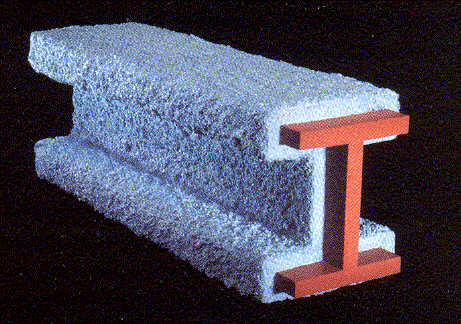
sprayed fireproofing
While a building fire isn’t hot enough to melt structural steel, it is hot enough to weaken it it to the point of failure. It is for this reason that building codes have begun to limit the use of exposed structural steel framing for many one and two story buildings, and most all that are 3 stories or more. Original steel fireproofing was approached by use of column encasement in concrete or masonry, which adequately but not aggressively limits the fire’s effect of weakening the structural steel. Eventually the additional weight and cost of this approach led to the development of metal lath and plaster around steel members. Plaster with vermiculate instead of sand has come to limit weight and increase insualting properties. Most presently, plaster fireproofing has largely been replaced by beam and column enclosures made of gypsum board materials.

In more fireproof critical areas and where the steel member fireproofing assembly does not need to double as a finish material, the use of spray applied fireproofing has become the construction method of choice. This product consists of a fire-resistive fiber slurry (mineral wool, quartz, perlite, or vermiculite) and a binder (often a cementitious mixture) and is sprayed over the steel member by way of an air-pressured spray gun to the desired thickness.


Chemical hardeners can also be specified which speed up or intensify the hardnening capability. Spray fireproofing can be wet or dry and can also be troweled on.
Wet-applied is known to be a bit more productive than dry applied. It commonly comes in a dry powder bag, and is mixed with water in the field. In general these products are available in weights of about 12-40lbs per cubic foot. The lighter mass materials are more susceptible to scuffing, scarring, and damage and thus are often covered with finish materials.



Spray applied fireproofing is generally considered the least expensive form of steel fireproofing. After application, a special gauge can be used to measure the thickness to assure the product has been installed to spec.
Spray-applied fireproofing can be applied in the shop before shipment for more economic, efficient, and cosistent application but this approach is rare due to the challenging logistic and the susceptibility to damage. In building applications of low/moderate risk, a new generation of fireproofing techniques and products were developed called intumescent mastic or paint. This product allows for better visual aesthetics than fibrous spray fireproofing and expands when exposed to intense heat which form a stable, thick, charred material that insulates the steel from heat for varying lengths of time (depending on coating thickness and product type). These products can often serve as a base coat under typical paint if special colors are desired.


Spray-applied fireproofing will adhere to bare steel, but not to an oily/rusty/or painted surface. Since structural steel in a building is commonly prime-painted either from the shop or in the field, the supplier or contractor supplying the steel must be mindful of leaving unprimed the pieces that will receive spray-applied fireproofing. If a primed steel member exists where spray fireproofing must go, it is common for lath to be shot-pinned to the steel to provide a proper substrate for adherence.
Not only will water lead to rust and rust to a surface that will poorly accept spray fireproofing, excessive moisture can also lead to the failure of installed fireproofing. For this reason, it is typical for fireproofing to be installed shortly after a building has been enclosed and ‘dried-in’. If there is connection hardware that must be applied to the steel members to receive fireproofing, these fasteners must be done prior to fireproofing else it will need scraped and patched at a later date. An unexpected, costly, messy, and time consuming proposition. Also metal decking is frequently specified to receive spray-applied fireproofing. Because by default metal decking is often lubricated during fabrication, it must be stripped of this oily film prior to shipping else it will require doing so in the field, another undesirable resolution.

Spray-applied fireproofing is often required on steel beams, columns, and girders that are very high in the air, requiring a lift to for access.

Spray-applied fireproofing commonly comes in three grades;
-Low/standard/commercial density- 15-21 lbs/cf – gypsum binder, higher yields and faster coverage rates, lower costs, have the propensity to flake over time due to contact, air flow, etc
-Medium Density- 22-39 lbs/cf – cement or gypsum/cement binder, more stable product than low density but should still not be used in high human traffic areas
-High Density – over 39 lbs/cf, cement binder, for use in high human traffic areas, mechanical rooms, parking garages, etc.
Bond strength requirements were vamped up after the 9/11 attacks. For a building with a height of 75 feet or lower, the bond strength will need to be 150psf. Thickness and fire rating typically go hand in hand and this data can be found in the data sheet of the product being utilized. During installation a minimum temperature (and 24 hours prior as well) should be at least 40F.

Because of the high amount of power required for spray equipment, dedicated power is typically required.
A water source on site will also be required for mixing the product. Prep work must consider: surfaces free of oil, grease, and dirt; all clamps/attachments to steel must be put in place, building dried in with roofing installed; adhesive or primers installed if required by manufacturer. Sometimes requirements will exist stating that the application of spray-applied waterproofing be done by a NFCA Accrediated contractor.
